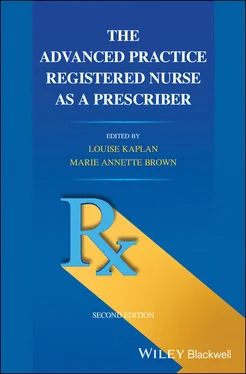Strategies for success as a prescriber
Changes in evidence‐based practice, patient‐centered outcomes research, and the introduction of new medications require regular review of patient medication regimens. A professional development plan will help the APRN utilize the most current evidence in medication management.
Participation in lifelong learning is the essence of a professional development plan. Different forms of lifelong learning may include collegial mentoring by another APRN, participation in professional organizations, informal networking with colleagues, peer review, and continuing education seminars or online training that focuses on current medication management approaches. Forty states require demonstration of continued competency to maintain licensure/recognition as an APRN; requirements vary from continuing education beyond the RN license requirement, pharmacology education, maintenance of national certification, practice, and peer review (NCSBN, 2020).
Efficient time management hinges on the APRN’s medication management expertise. One approach to enhance prescribing effectiveness is to develop a “personal formulary” of medications one typically prescribes from different drug classes or for specific health conditions. This personal formulary is developed through current evidence, experience, patient feedback and responses to medications, and financial considerations.
Besides the use of a personal formulary, the APRN may employ strategies for prescribing drugs that save time and reduce the incidence of errors in medication management. Electronic prescribing reduces errors associated with illegibly written and improper prescriptions which often require a pharmacist to seek clarification. Nonetheless, errors related to electronic prescribing occur within hospital and community settings from both the provider side and the pharmacist side (Abramson, 2015; Alex et al., 2016). The need to communicate with pharmacists continues and will facilitate medication monitoring and prescription renewal.
In the interest of safety, it is recommended that patients use one pharmacy only. In situations when the APRN is concerned a patient is misusing medications, there are programs through private and public health plans that can mandate use of one pharmacy only. Use of one pharmacy reduces medication errors, drug interactions, and multiple prescriptions from multiple providers for the same medication, particularly scheduled drugs. An example of a public program that can mandate one pharmacy only is the Washington State Medicaid program known as Patient Review and Coordination which addresses overall excess utilization of services including medication use. Clients assigned to the program have had a 33% decrease in emergency room use, 37% decrease in office visits, and 24% decrease in prescriptions (Washington State Health Care Authority, 2020).
Novice prescribers may require an extensive amount of time to consult references, electronic medication guides, and clinical guidelines to select the most appropriate medication and write prescriptions. Electronic health records (EHRs) usually provide medication choices written with the generic rather than the brand name. Sometimes the desired dose or delivery approach is not specified in the dropdown menu, so consultation with peers can be especially useful in adapting to a new EHR. Because the development of expertise will take time and occurs over months and years, APRNs are encouraged to have realistic expectations of the time required to develop competence and be patient with themselves during this process.
An analysis of how patients, prescribers, experts, and patient advocates view the prescription choice process identified five important factors: information, relationship, patient variation, practitioner variation, and role expectations. The researchers noted that “decisions regarding the selection and use of prescription medications are made by multiple individuals, at multiple times, in multiple locations, under different contexts and viewpoints. The prescription choice process may be complicated further by various abilities, beliefs, and motivations held by those involved in the decisions” (Schommer et al., 2009, p. 167). Indeed, prescribing medications may appear easy but in actuality is complex.
BARRIERS TO TRANSITIONING TO THE PRESCRIBER ROLE
Some barriers may impede rather than facilitate role transition and the APRN’s assumption of the prescriber role. Prescribing is the aspect of the APRN role most commonly constrained by legal requirements for physician collaboration or supervision. Prior to obtaining CS prescriptive authority, Washington State APRNs experienced numerous barriers to assure their patients received the CSs they needed. The three most common barriers were physician concern about possible liability as a collaborator, a physician and NP choosing different drugs, and physician reluctance to prescribe drugs selected by the NP (Kaplan & Brown, 2004). For APRNs in states with required collaborative agreements or supervision for prescribing, thoughtful conversations with a physician colleague may reduce misconceptions and discord. Even in states with full practice authority, physicians who employ APRNs may expect to have input into an APRN’s prescribing decisions.
A FRAMEWORK FOR PRESCRIBING
Rational prescribing
Rational prescribing rests on knowledge of the patient, knowledge about the nature of the health problem, and treatment using evidence‐based guidelines, standards of care, strategies for promoting medication use, health plan coverage, and socioeconomic factors. With this information, the APRN and the patient make a shared decision through consideration of the benefits and burdens in the patient’s particular situation. Both need to be mindful of the APRN’s responsibility to act in the best interest of the patient. There are four general elements to rational prescribing: knowledge of the patient, knowledge of the disease and standard management, patient education and shared decision making, and maintaining a trust relationship with the patient.
Proper prescribing of medications requires careful evaluation of the patient with consideration of the patient’s health history, medication history, and physical assessment. A complete medication history includes herbal and non‐prescription medications, prescription medications, recreational drugs, and all drug reactions. This more comprehensive approach involves assessing allergic responses, drug interactions, and family genetic propensities. Thirty‐three states, the District of Columbia, Guam, Puerto Rico, and the US Virgin Islands have legalized medical marijuana and 14 states and territories have approved adult use marijuana (National Conference of State Legislatures, 2020). It is important to know about patient use of marijuana to be able to effectively guide patients with evidence‐based information when the APRN is authorized by law (see Chapter 9).
One important but often forgotten area of assessment is the patient’s ability to manage his or her own medications. Names of drugs and the purpose of each drug may pose challenges for many patients. Assessment of the patient’s motivation, cognitive abilities, attitudes about medication management, self‐care, readiness to learn, health literacy, occupation, and educational background is essential to avoid false assumptions about the patient’s ability to follow the healthcare plan. For example, a provider may incorrectly assume that a patient who is a nurse does not require the same counseling as other patients about medication side effects. Some patients with unusual chronic problems may be more knowledgeable about their illness and medication management than the APRN. Others may be inexperienced, misinformed, and/or uninformed about the medications they use.
Читать дальше












